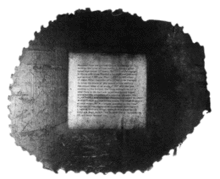USS General G. W. Goethals (ID-1443)
USS General G. W. Goethals (ID-1443) was a United States Navy cargo ship and troop transport in commission in 1919.
.jpg) SS General G. W. Goethals sometime between 1917 and 1919, prior to her U.S. Navy service, with the barge Ethel and Lillian alongside. | |
| History | |
|---|---|
| Name: | USS General G. W. Goethals |
| Namesake: | George Washington Goethals (1858-1928), a U.S. Army officer and civil engineer (Previous name retained) |
| Builder: | Bremer Vulkan, Vegesack, Germany |
| Completed: | 1911 or 1912[2] |
| Acquired: | 10 March 1919 |
| Commissioned: | 10 March 1919 |
| Decommissioned: | 13 September 1919 |
| Fate: | Transferred to United States Department of War 13 September 1919 for return to owner |
| Notes: | In commercial service as SS Grunewald and SS General G. W. Goethals prior to 1919 and as SS General G. W. Goethals from 1919 |
| General characteristics | |
| Type: | Cargo ship and troop transport |
| Tonnage: | 4,707 gross tons |
| Displacement: | 2,783 tons (normal) |
| Length: | 367 ft (112 m) |
| Beam: | 48 ft 7 in (14.81 m) |
| Draft: | 27 ft 6 in (8.38 m) (mean) |
| Propulsion: | Steam engine |
| Speed: | 11 knots (maximum) |
| Armament: | None |
Construction and acquisition
General G. W. Goethals was built in 1911 or 1912[2] as the German commercial passenger-cargo ship SS Grunewald at Vegesack, Germany, by Bremer Vulkan. Before the United States entered World War I, she became an American ship owned by the Panama Railroad Steamship Company of New York City. The U.S. Navy acquired her on 10 March 1919, assigned her the naval registry Identification Number (Id. No.) 1443, and commissioned her the same day at Hoboken, New Jersey, as USS General G. W. Goethals with Lieutenant Commander Edward O. Roberts, USNRF, in command.
United States Navy service
.jpg)
Assigned to the Cruiser and Transport Force and operated by the Navy under a United States Army account, General G. W. Goethals spent the bulk of her commissioned Navy service ferrying supplies for American forces in Europe to France and bringing home troops of the American Expeditionary Force who had served in Europe during World War I. Leaving New York City on 2 April 1919 for her first transatlantic voyage, she carried supplies to Bordeaux, France, returning to the United States on 4 May 1919. Subsequently she made two more voyages to Europe with supplies, and brought home nearly 3,000 troops.
On 21 August 1919, General G. W. Goethals departed Charleston, South Carolina, carrying supplies to New Orleans, Louisiana; Cristóbal, Panama Canal Zone; and San Juan, Puerto Rico. She completed this voyage by arriving at New York City on 13 September 1919.
On the day of her arrival in New York, General G. W. Goethals was decommissioned and turned over to the United States Department of War for return to the Panama Railroad Steamship Company.
Later career
The ship returned to commercial service as SS General G. W. Goethals.
Assistance to USS S-5

On 2 September 1920, General G. W. Goethals was off Cape May, New Jersey, on a voyage from Haiti to New York City when the wooden steamship Alanthus contacted her at about 18:00 by the use of signal flags. Making her last voyage, Alanthus earlier in the day had come across the disabled U.S. Navy submarine USS S-5 (SS-110), which had sunk accidentally on 1 September 1920 during full-power trials off the Delaware Capes. The submarine's crew had partially refloated her, causing her to rise until only her stern broke the surface, but had been able to make only a tiny hole in her hull in their attempt to escape and remained trapped on board. Alanthus had rigged a pump to provide S-5's crew with air and had also provided the submarine's crew with fresh water and rigged cables to keep S-5's stern above water, but had been unable to help the crew enlarge the escape hole or, lacking a radio, to call for assistance until sighting General G. W. Goethals.[3][4]
General G. W. Goethals radioed the U.S. Navy with its first information about the submarine's plight and her crew immediately set about enlarging the escape hole. By 01:45 on 3 September 1920, the hole was big enough for S-5's crew to exit the submarine, and the last man to leave – S-5's commanding officer, Lieutenant Commander Charles M. "Savvy" Cooke, Jr. – safely emerged from the escape hole at 03:00. Although her crew was safe, the submarine was lost later on 3 September when she sank while under tow by the battleship USS Ohio.[4]
The portion of S-5's hull plating that General G. W. Goethals removed to permit S-5's crew to escape from the submarine is on exhibit in the National Museum of the United States Navy in the Washington Navy Yard in Washington, D.C.
Sale
On 10 January 1925, the Panama Railroad Steamship Company sold General G. W. Goethals to the Universal Negro Improvement Association.
See also
Notes
- Per the U.S. Naval Historical Center Online Library of Selected Images (at http://www.history.navy.mil/photos/sh-civil/civsh-g/gen-goet.htm)
- OnlineLibrary, Alanthus
- Rear, Laura, "History of the USS S-Five Submarine," oceanexplorer.noaa.gov, undated.
References
- This article incorporates text from the public domain Dictionary of American Naval Fighting Ships. The entry can be found here.
- Department of the Navy: Naval Historical Center Online Library of Selected Images: Civilian Ships: S.S. General G.W. Goethals (American Passenger-Cargo Steamer, 1911). Served as USS General G.W. Goethals (ID # 1443) in 1919
- NavSource Online: Section Patrol Craft Photo Archive: General G. W. Goethals (ID 1443)